| Revision as of 22:22, 5 March 2013 ddgonzal (Talk | contribs) <- Previous diff |
Revision as of 00:23, 28 July 2015 ddgonzal (Talk | contribs) Next diff -> |
||
| Line 42: | Line 42: | ||
| From the same engineers who brought you the Z-car. | From the same engineers who brought you the Z-car. | ||
| - | [[Category:General Information]] | ||
| [[Category:Datsun B210]] | [[Category:Datsun B210]] | ||
Revision as of 00:23, 28 July 2015
Fuel Economy Champion
Overview
B210 was consistently at or near the top of the fuel ecomony leaders.
1974 41 mpg with A13 engine and 4-speed
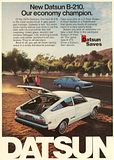

1975 39 mpg, 27 mpg city with A14 engine and 4-Speed
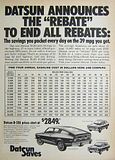
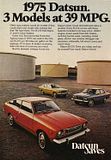
1975 41 mpg, 27 mpg city with A14 engine and 4-Speed
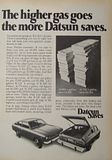
1975-1/2 41 mpg Honey Bee with A14 engine and 4-Speed. Honey Bee was a STD model (lightweight stripper model)
1976 4-speed: 41 mpg highway, 29 mpg city with A14 engine
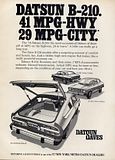
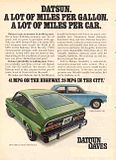
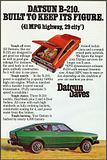
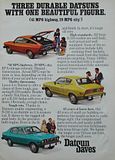
1976 Automatic: 34 mpg highway, 26 mpg city with A14 engine (70 HP SAE NET, 68 HP California)
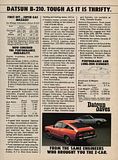
1976.5 5-speed FED: 44 mpg highway, 29 mpg city with "3.70 rear axle"
1976.5 5-speed CAL: 43 mpg highway, 30 mpg city with "3.70 rear axle"
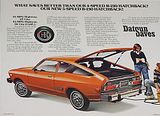
1976 5-speed: 42 mpg highway, 28 mpg city with A14 engine Hatchback advertisement "Suddenly it's going to dawn on you"

1977 47 mpg highway, A14 with 5-speed (California)
1977 50 mpg highway, 37 mpg city with A14 engine and 5-speed:

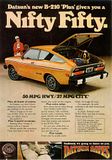
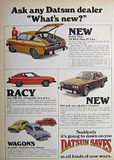
1978 48 mpg highway, 36 mpg city with A14 and 5-speed

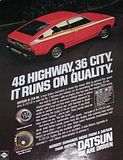
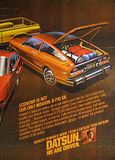
This was the peak of Nissan fuel economy, at least in a regular size (over 660 cc) car.
The introduction of 5-speeds, per the Datsun Service Bulletin was "1976 1/2". All the 5-speed B210s were the big heavy 63A model. Which is ironic because they were all fitted to lo-po A14s. Apparently Nissan had no smaller 5-speeds to handle the torque of A14, so it was converted to A-series use just after the fuel crisis.
From the same engineers who brought you the Z-car.

![[Datsun 1200 encyclopedia]](/wiki/upload/wiki.png)